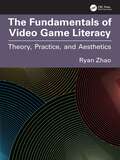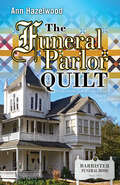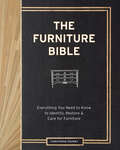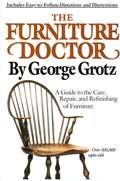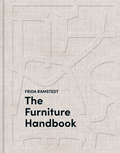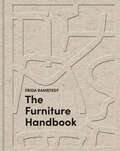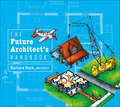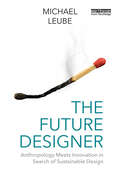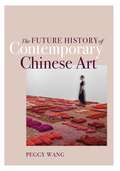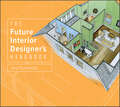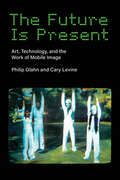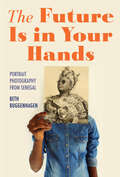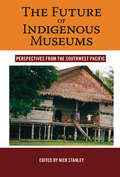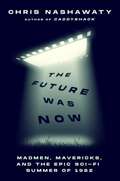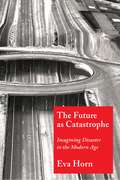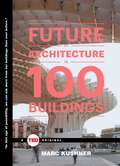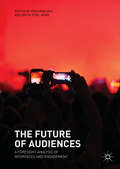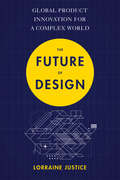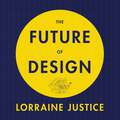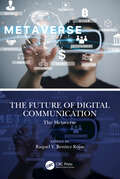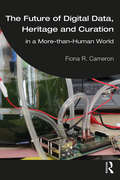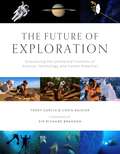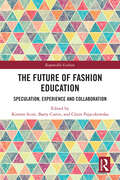- Table View
- List View
The Fundamentals of Video Game Literacy: Theory, Practice, and Aesthetics
by Ryan ZhaoThis book posits a novel framework for sense‑making and meaning‑making in the play of video games. Extending a modern, process‑oriented, audience‑inclusive philosophy of artistic meaning generation, this book grapples with the question of how to personally and critically examine video games as artistic artifacts that do not have set, predetermined, standardized forms until live play is enacted. The resulting artistic product, live gameplay, expresses both the game’s developers and its players.This book argues that players hold three separate, concurrent perspectives during play: the embodied avatar within the simulated space, the role‑playing participant in the narrative fantasy, and the external strategist manipulating the game’s software affordances. The exciting dynamics that arise from live gameplay are the result of the tensions and harmonies between these three parallel layers of play.Video games are systems with designed behaviors capable of a great diversity of instantiated expressions. Players are brought into that system of instantiated generation to produce truly emergent and personal gameplay. As such, players directly impact the shape and form of the gameplay artifact itself. This creates a relationship between the art, the player, and its meaning radically different from all previous art forms.This book builds around this central premise with examinations of related subjects pertaining to video game meaning‑making, such as the ways in which video games facilitate play that is expressive of their players and the ways in which it is appropriate to compare and contextualize the differences in players’ instantiated play activities. These subjects are designed to give readers an in‑depth understanding of the dynamics of gameplay in order to facilitate richer, more meaningful encounters with video games as cultural artifacts.This book: Provides a useful framework for enriching players’ experiences with video game play. Helps players identify and distinguish aspects of their own and game developers’ expression in gameplay. Posits a novel framework examining the role of player as embodied avatar, role‑player, and strategist. Gives players appropriate questions to better interrogate the generation of meaning from within and surrounding the system of gameplay.
The Funeral Parlor Quilt (Colebridge Community Series)
by Ann HazelwoodAfter quitting her boring editing job, aspiring writer Lily Rosenthal isn't sure what to do next. Her only joys in life are collecting antique quilts and frequenting the area's beautiful wine country. The murder of a friend results in her inheriting the inventory of a local antique store. She begins to consider opening her own shop, even though this will mean uprooting her life. With some help from her sisters, a ghost, and a handsome baseball fan, Lily embarks on a journey filled with laughs, loss, and red-and-white quilts.
The Furniture Bible: Everything You Need to Know to Identify, Restore & Care for Furniture
by Martha Stewart Jen Renzi Christophe PournyChristophe Pourny learned the art of furniture restoration in his father’s atelier in the South of France. In this, his first book, he teaches readers everything they need to know about the provenance and history of furniture, as well as how to restore, update, and care for their furniture—from antiques to midcentury pieces, family heirlooms or funky flea-market finds. The heart of the book is an overview of Pourny’s favorite techniques—ceruse, vernis anglais,and water gilding, among many others—with full-color step-by-step photographs to ensure that readers can easily replicate each refinishing technique at home. Pourny brings these techniques to life with a chapter devoted to real-world refinishing projects, from a veneered table to an ebonized desk, a gilt frame to a painted northern European hutch. Rounding out this comprehensive guide is care and maintenance information, including how to properly clean leather, polish hardware, fix a broken leg, and replace felt pads, as well as recipes to make your own wax, shellac, varnish, stain, and more.
The Furniture Doctor: A Guide to the Care, Repair, and Refinishing of Furniture
by George GrotzThe best-selling guide to keeping furniture in the finest and most beautiful condition, with complete information on proper repair and refinishing techniques from the legendary expert on antiques and their restoration.B & W photographs throughoutFrom the Trade Paperback edition.
The Furniture Handbook: A Guide to Choosing, Arranging, and Caring for the Objects in Your Home
by Frida RamstedtThe comprehensive guide to living with furniture, no matter your style, from the author of The Interior Design Handbook. Interior-design sensation Frida Ramstedt changed how we think about designing a harmonious home with her book The Interior Design Handbook. Now she brings that same authoritative and comprehensive focus to this complementary guide that&’s all about the most essential and functional items within your home. No matter your style of home, we all want our spaces to feel inviting and comfortable. And the key to that is quality furniture that supports your lifestyle. The Furniture Handbook shares the foundational rules of choosing, arranging, and caring for the furniture in every room of your home. From selecting the perfect size dining table and seating that fits your family to arranging your living room pieces for the best flow, the basic principles that interior designers use and that everyone should master are provided.• Know what to pay extra attention to when choosing and rearranging furniture and what common complaints people have so you can avoid them.• Understand the dimensions and details of furniture design that determine whether a piece is comfortable or not.• Select quality upholstery that looks beautiful and will endure wear and tear from pets, kids, and daily life.• Learn how to match the scale of different pieces and plan what goes where before you start moving your furniture, so you never regret the time and money you have invested. Complete with simple and elegant illustrations, The Furniture Handbook is your key to creating beautiful, personal spaces in your home.
The Furniture Handbook: A Guide to Choosing, Arranging, and Caring for the Objects in Your Home
by Frida RamstedtThe comprehensive guide to living with furniture, no matter your style, from the author of The Interior Design Handbook.Interior-design sensation Frida Ramstedt changed how we think about designing a harmonious home with her book The Interior Design Handbook. Now she brings that same authoritative and comprehensive focus to this complementary guide that&’s all about the most essential and functional items within your home.No matter your style of home, we all want our spaces to feel inviting and comfortable. And the key to that is quality furniture that supports your lifestyle. The Furniture Handbook shares the foundational rules of choosing, arranging, and caring for the furniture in every room of your home. From selecting the perfect size dining table and seating that fits your family to arranging your living room pieces for the best flow, the basic principles that interior designers use and that everyone should master are provided.Know what to pay extra attention to when choosing and rearranging furniture and what common complaints people have so you can avoid them.Maximize form and function for the pieces in your home, so you have furniture that is practical, beautiful, and cohesive. Choose the right scale and materials for your space, regardless of how big or small.Understand the dimensions and details of furniture design that determine whether a piece is comfortable or not.Select quality upholstery that looks beautiful and will endure wear and tear from pets, kids, and daily life.Make better choices for every room in your home and create the space you want to live inComplete with simple and elegant illustrations, The Furniture Handbook is your key to creating beautiful, personal spaces in your home.
The Future Architect's Handbook
by Barbara BeckFor young readers with a passion for drawing or creating beautiful buildings, The Future Architect’s Handbook takes them on an exhilarating journey into the world of architecture. Within the pages of this book, aspiring, young architects will learn about the four essential drawings used by professionals: the site plan, floor plan, section, and elevation. Perfectly tailored with the middle grades (ages 9–12) in mind, this book engages the reader with vivid explanations and illustrations. The concept of drawing each plan to scale is demystified, empowering young minds to develop an eye for precision and accuracy. Explore the vast array of architectural styles prevalent today: from sleek modern structures to timeless classical masterpieces, each style is beautifully showcased, igniting the imagination and nurturing a deeper appreciation for the art of architecture. Enter the world of architects and discover the boundless possibilities that await within the pages of The Future Architect’s Handbook.
The Future Designer: Anthropology Meets Innovation in Search of Sustainable Design
by Michael LeubeDuring periods of environmental and societal upheaval, design has the potential to be a formidable catalyst towards a sustainable future. However, to unleash its full power, significant shifts in both theory and practice are imperative. This book adopts a unique approach, blending anthropological perspectives with philosophy and cognitive science, and advocates for a thorough transformation of the existing design curriculum.Supported by a vast body of literature in evolutionary science and design research, the book presents a blueprint for fostering more sustainable patterns of production and consumption. This blueprint is grounded in human virtues rather than vices and proposes a new curriculum tailored towards pro-sociality and sustainability. Leveraging his extensive professional background and expertise in the circular economy, Michael Leube offers practical examples, methods and tools for implementing sustainable approaches in the practical work of experienced designers. Showcasing cutting-edge innovations for pro-social and humanitarian design, the book ultimately argues that if we change the objective of design from creating desire to creating value, we can solve many of the most pressing social problems, from the cooperation of citizens to sustainable cities.The book will be useful for those studying and teaching design and anthropology, and it will also be an important tool for practicing designers and engineers interested in learning how to design for social and ecological awareness.
The Future History of Contemporary Chinese Art
by Peggy WangA revelatory reclaiming of five iconic Chinese artists and their place in art history During the 1980s and 1990s, a group of Chinese artists (Zhang Xiaogang, Wang Guangyi, Sui Jianguo, Zhang Peili, and Lin Tianmiao) ascended to new heights of international renown. Even as their fame increased, they came to be circumscribed by simplistic Western interpretations of their artworks as social and political critiques, a perspective that privileged stories of dissidence over deep engagement with the art itself. Through in-depth case studies of these five artists, Peggy Wang offers a corrective to previous appraisals, demonstrating how their works address fundamental questions about the forms, meanings, and possibilities of art. By the end of the 1980s, Chinese artists were scrutinizing earlier waves of Western influence and turning instead to their own heritage and culture to forge their own future histories. As the national trauma of the 1989 Tiananmen Square massacre converged with the mounting expansion of the global art world, these artists turned to art as a profoundly generative site for grappling with their place in the world. Wang demonstrates how they consciously and energetically sought to make their own ideas about art and art history visible in contemporary art. Wang&’s argument is informed by extensive primary research, including close examination of the artworks, analysis of Chinese language documents and archives, and deeply personal interviews with the artists. Their words uncover layers of meaning previously obscured by the popular and often recycled assessments that many of these works have received until now. Beyond Wang&’s reinterpretation of these individual artists, she contributes to an urgent conversation on the future direction of art history: how do we map engagements between art from different parts of the world that are embedded within different art histories? What does it mean for histories of contemporary art—and art history more generally—to be inclusive? The new understandings offered in this book can and should be engaged when considering current hierarchies in histories of Chinese art, the global art world, and the intersections between them.
The Future Interior Designer's Handbook
by Jana RosenblattCalling all aspiring interior designers! Get ready to dive into the captivating world of interior design with a book that introduces you to the role, techniques, and skills of interior design. You are invited to follow Taylor, a talented interior designer, as she transforms the unfinished attic of her home into a stunning living space. Step by step, readers will learn the ins and outs of the design process, gaining invaluable knowledge along the way. Unleash your creativity as you explore the three main drawings used by interior designers: the floor plan, section, and elevation. Discover the art of drawing to scale, enabling you to accurately represent your vision on paper. From initial planning to the final touches, this book guides you through each stage, teaching essential design techniques, basic color theory, mood board creation, and the architectural styles that shape modern interiors. The Future Interior Designer's Handbook is the perfect introduction to the captivating field of interior design. While it caters to the middle grades, ages 8–12, this book's wealth of knowledge and inspiration will resonate with design enthusiasts of all ages, including adults who are eager to explore their creative potential.
The Future Is Present: Art, Technology, and the Work of Mobile Image (Leonardo)
by Cary Levine Philip GlahnA critical history of the pioneering art and technology group Mobile Image and their prescient work in communications, networking, and information systems.In The Future Is Present, Philip Glahn and Cary Levine tell the fascinating history of the visionary art group Mobile Image—founded by Kit Galloway and Sherrie Rabinowitz in 1977—which appropriated emerging technologies, from satellites to electronic message platforms. Based in Los Angeles, this under-studied collective worked amid urban crisis, a techno-boom, consolidating media power, and ascendant neoliberal politics. Mobile Image challenged fundamental conventions of the public sphere, democracy, communication, and political participation, as well as notions of power, representation, and identity.Glahn and Levine argue not only for the historical importance of Mobile Image, but also for a critical artistic process that is at once analytic and transformative. They weave themes such as embodiment and its mediation, public/private dialectics, and techno-utopian vision throughout the book, binding these projects to discourses around race, gender, and class, as well as margin and center, the local and the global. In today&’s world of ubiquitous digital re/production, networking, and social media, The Future Is Present shows how the work of Mobile Image continues to have profound implications for art, technology, and the politics of public and private experience.
The Future Is in Your Hands: Portrait Photography from Senegal (Material Vernaculars)
by Beth BuggenhagenIn Senegal, portraiture serves as a vital index and creator of social connection. People sit for and display portraits, keep albums, and view illustrated magazines together. Through these portraiture practices, Senegalese have fashioned idealized images to mend fraught and fragmented lives in the context of decades of migration. The Future Is in Your Hands provides an expansive frame for photography to highlight the role of affect in portraiture practices. Moving from the colonial to the newly independent Senegal, Beth Buggenhagen combines museum, ethnographic, and archival research on photography's past with lens-based artists who address themes of separation, visibility, rupture, and repatriation through portraiture. Buggenhagen, in collaboration with Senegalese photographers, explores how photographs, as visual and material objects, migrate themselves and, like the bodies they represent, create a record not only of lived experiences but also of the cycle of migration for this labor-exporting country.By complicating the history of portraiture in Senegal, The Future Is in Your Hands reveals the enduring power of images and the efforts under way to keep this art form safely in Senegalese hands.
The Future Of Indigenous Museums
by Nick StanleyIndigenous museums and cultural centres have sprung up across the developing world, and particularly in the Southwest Pacific. They derive from a number of motives, ranging from the commercial to the cultural political (and many combine both). A close study of this phenomenon is not only valuable for museological practice but, as has been argued, it may challenge our current bedrock assumptions about the very nature and purpose of the museum. This book looks to the future of museum practice through examining how museums have evolved particularly in the non-western world to incorporate the present and the future in the display of culture. Of particular concern is the uses to which historic records are put in the service of community development and cultural renaissance.
The Future Was Now: Madmen, Mavericks, and the Epic Sci-Fi Summer of 1982
by Chris Nashawaty“Hollywood boldly went where it hadn’t gone before and Nashawaty chronicles the journeys.” —Los Angeles Times ("Books You Need To Read This Summer")“Written with a fan’s enthusiasm . . . An important inflection point in Hollywood filmmaking.” —New York Times ("Nonfiction Books to Read This Summer")In the summer of 1982, eight science fiction films were released within six weeks of one another. E.T., Tron, Star Trek: Wrath of Khan, Conan the Barbarian, Blade Runner, Poltergeist, The Thing, and Mad Max: The Road Warrior changed the careers of some of Hollywood's now biggest names—altering the art of movie-making to this day.In The Future Was Now, Chris Nashawaty recounts the riotous genesis of these films, featuring an all-star cast of Hollywood luminaries and gadflies alike: Steven Spielberg, at the height of his powers, conceives E.T. as an unlikely family tale, and quietly takes over the troubled production of Poltergeist, a horror film he had been nurturing for years. Ridley Scott, fresh off the success of Alien, tries his hand at an odd Philip K. Dick story that becomes Blade Runner—a box office failure turned cult classic. Similar stories arise for films like Tron, Conan the Barbarian, and The Thing. Taken as a whole, these films show a precarious turning-point in Hollywood history, when baffled film executives finally began to understand the potential of high-concept films with a rabid fanbase, merchandising potential, and endless possible sequels.Expertly researched, energetically told, and written with an unabashed love for the cinema, The Future Was Now is a chronicle of how the revolution sparked in a galaxy far, far away finally took root and changed Hollywood forever.
The Future as Catastrophe: Imagining Disaster in the Modern Age
by Eva HornWhy do we have the constant feeling that disaster is looming? Beyond the images of atomic apocalypse that have haunted us for decades, we are dazzled now by an array of possible catastrophe scenarios: climate change, financial crises, environmental disasters, technological meltdowns—perennial subjects of literature, film, popular culture, and political debate. Is this preoccupation with catastrophe questionable alarmism or complacent passivity? Or are there certain truths that can be revealed only in apocalypse?In The Future as Catastrophe, Eva Horn offers a novel critique of the modern fascination with disaster, which she treats as a symptom of our relationship to the future. Analyzing the catastrophic imaginary from its cultural and historical roots in Romanticism and the figure of the Last Man, through the narratives of climatic cataclysm and the Cold War’s apocalyptic sublime, to the contemporary popularity of disaster fiction and end-of-the-world blockbusters, Horn argues that apocalypse always haunts the modern idea of a future that can be anticipated and planned. Considering works by Lord Byron, J. G. Ballard, and Cormac McCarthy and films such as 12 Monkeys and Minority Report alongside scientific scenarios and political metaphors, she analyzes catastrophic thought experiments and the question of survival, the choices legitimized by imagined states of exception, and the contradictions inherent in preventative measures taken in the name of technical safety or political security. What makes today’s obsession different from previous epochs’ is the sense of a “catastrophe without event,” a stealthily creeping process of disintegration. Ultimately, Horn argues, imagined catastrophes offer us intellectual tools that can render a future shadowed with apocalyptic possibilities affectively, epistemologically, and politically accessible.
The Future of Architecture in 100 Buildings (TED Books)
by Marc KushnerThe founder of Architizer.com and practicing architect draws on his unique position at the crossroads of architecture and social media to highlight 100 important buildings that embody the future of architecture.We’re asking more of architecture than ever before; the response will define our future. A pavilion made from paper. A building that eats smog. An inflatable concert hall. A research lab that can walk through snow. We’re entering a new age in architecture—one where we expect our buildings to deliver far more than just shelter. We want buildings that inspire us while helping the environment; buildings that delight our senses while serving the needs of a community; buildings made possible both by new technology and repurposed materials. Like an architectural cabinet of wonders, this book collects the most innovative buildings of today and tomorrow. The buildings hail from all seven continents (to say nothing of other planets), offering a truly global perspective on what lies ahead. Each page captures the soaring confidence, the thoughtful intelligence, the space-age wonder, and at times the sheer whimsy of the world’s most inspired buildings—and the questions they provoke: Can a building breathe? Can a skyscraper be built in a day? Can we 3D-print a house? Can we live on the moon? Filled with gorgeous imagery and witty insight, this book is an essential and delightful guide to the future being built around us—a future that matters more, and to more of us, than ever.
The Future of Audiences: A Foresight Analysis Of Interfaces And Engagement
by Brita Ytre-Arne Ranjana DasThis book brings together contributions from scholars across Europe to present findings from a foresight analysis exercise on audiences and audience analysis, looking towards an increasingly datafied world and anticipating the ubiquity of the internet of things. The book uses knowledge emerging out of three foresight exercises, produced in co-operation with more than 50 stake-holding organisations and building on systematic reviews of audience research. It works through these exercises to arrive at a renewed agenda for audience studies within communication scholarship in the context of intrusive and connected interfaces and emerging communicative practices.
The Future of Design Education: Proceedings of InFuSED23 (Design Science and Innovation)
by Amaresh Chakrabarti Vishal Singh Shakuntala AcharyaThis book showcases cutting-edge research contributions from the International Symposium on Future of Design Education (InFuSED23) – written by eminent researchers from across the world on the topic ‘Future of Design Education’. The world is witnessing phenomenal change in terms of digital connectivity, movement from villages to towns and to megacities, major demographic movement across socio-economic strata, the looming threat of climate change and unsustainable development, terrorism and regionalism, major geopolitical shifts in the world order, and others. The practice of design, the “interdisciplinary discipline” as described by Nigel Cross, will have to play a major role in addressing the consequences of these changes, which by their very nature are people-centric and interdisciplinary. Therefore, design education must play a central role in training young minds in their evolving contributions as generic, empathic problem solvers for the world. InFuSED23 is intended to bring together top design researchers, teachers and thought leaders from across the world to deliberate on the topic “the future of design education” in its multiple perspectives: the aspects of design in which to train designers and design researchers, the manner in which the training is to be imparted, the levels at which training must be carried out, and so on.
The Future of Design: Global Product Innovation for a Complex World
by Lorraine JusticeCreating a successful global product is complex. Why do some products survive or become reinvented? What makes a product loved by some and despised by others? What key issues were present when some of the most notable inventions and product designs occurred? Through interviews with successful product designers and inventors from around the world, and case studies of products from their local inception to their global success, The Future of Design will answer these important questions and provide a robust framework for activating innovative thinking that goes beyond Western approaches to creativity and innovation.
The Future of Design: Global Product Innovation for a Complex World
by Lorraine JusticeHow can today's designers better engage with new and emerging technologies to take advantage of the opportunities these technologies can bring?"An insightful treatment of how design must change to address the many challenges with a world of global companies and design teams."--Don Norman, author, The Design of Everyday Things WHAT ARE THE 10 GLOBAL FACTORS THAT DETERMINE DESIGN SUCCESS?Using a wealth of examples from across multiple industries and countries, design expert Lorraine Justice fully explores the factors that will determine your success and provides a unique framework for navigating the industry into the future.You will learn how design and innovation are being impacted by new and emerging technologies, societal demands, cultural shifts, and broader world issues. The Future of Design is practical, concise and includes guidelines for building and supporting creative teams, advice and strategies for evaluating product concepts, and interviews with product designers, inventors, and innovators from around the world.
The Future of Design: Global Product Innovation for a Complex World
by Lorraine JusticeCreating a successful global product is complex. Why do some products survive or become reinvented? What makes a product loved by some and despised by others? What key issues were present when some of the most notable inventions and product designs occurred? Through interviews with successful product designers and inventors from around the world, and case studies of products from their local inception to their global success, The Future of Design will answer these important questions and provide a robust framework for activating innovative thinking that goes beyond Western approaches to creativity and innovation.(P) 2019 Hodder & Stoughton Ltd
The Future of Digital Communication: The Metaverse
by Raquel V. Benítez RojasThis collection of essays explores the present and future of digital communication through a range of interdisciplinary approaches, all of which focus on the so-called metaverse. The metaverse is a combination of multiple elements of technology – including virtual reality, augmented reality, and video – where users "live" within a digital universe. The vision for this new universe is that its users can work, play, and stay connected with friends through everything. Such a vision is hinted at in existing phenomena such as online game universes.
The Future of Digital Data, Heritage and Curation: in a More-than-Human World
by Fiona R. CameronThe Future of Digital Data, Heritage and Curation critiques digital cultural heritage concepts and their application to data, developing new theories, curatorial practices and a more-than-human museology for a contemporary and future world. Presenting a diverse range of case examples from around the globe, Cameron offers a critical and philosophical reflection on the ways in which digital cultural heritage is currently framed as societal data worth passing on to future generations in two distinct forms: digitally born and digitizations. Demonstrating that most perceptions of digital cultural heritage are distinctly western in nature, the book also examines the complicity of such heritage in climate change, and environmental destruction and injustice. Going further still, the book theorizes the future of digital data, heritage, curation and the notion of the human in the context of the profusion of new types of societal data and production processes driven by the intensification of data economies and through the emergence of new technologies. In so doing, the book makes a case for the development of new types of heritage that comprise AI, automated systems, biological entities, infrastructures, minerals and chemicals – all of which have their own forms of agency, intelligence and cognition. The Future of Digital Data, Heritage and Curation is essential reading for academics and students engaged in the study of museums, archives, libraries, galleries, archaeology, cultural heritage management, information management, curatorial studies and digital humanities.
The Future of Exploration: Discovering the Uncharted Frontiers of Science, Technology, and Human Potential
by Chris Rainier Terry GarciaAt this very moment, explorers in some of the most remote and dangerous places on earth, from the deepest parts of the ocean, to the highest mountains, and to outer space are enduring unimaginable hardships to expand our knowledge and save what is truly important.Join former National Geographic Executive Vice President and Chief Science Officer Terry Garcia and nature and cultural photographer Chris Rainier, a National Geographic Explorer, on a journey with some of the world&’s most renowned and respected explorers, scientists, astronauts, visionaries, thinkers, and authors as they discuss and share their insights about what motivates them, what is left to explore, and why we should care in The Future of Exploration. Exploration is as old as humankind, but there are still surprises that await us. With technology opening doors that once seemed permanently closed, the twenty-first century will be the greatest age of exploration in our history. Accompanied with awe-inspiring photography, each contributor shares their personal achievements and insight into what the future of exploration looks like from their respective fields, the challenges we face, and possible solutions. Whether delving into the terrestrial, oceanic, or cosmic frontiers, embark on a journey into the uncharted future and be inspired yourself to be a part of the future of exploration.
The Future of Fashion Education: Speculation, Experience and Collaboration (Responsible Fashion)
by Claire Pajaczkowska Barry Curtis Kirsten ScottFashion education is changing. Not only is it preparing students for induction into the ethos and business practices of a wide variety of design, manufacturing, distribution, marketing, retailing, and promotional activities, it is also offering understanding and empowerment for meeting the challenges of sustainability, decolonisation, and new business models. This book presents 20 essays by cosmopolitan thinkers, activists, and designers to explore new challenges and potentials for fashion education.The chapters comprise case studies, manifestos, and detailed analyses of the realpolitik of collaborating across continents and more sustained overviews of the imminent crises and prospective challenges that face practitioners. Recurring themes include the geopolitics of globalisation, the imbalances between North and South, decolonisation, intersectionality, exploitation, cultural appropriation, and social justice. The thought-provoking contributions show that, although we confront a common challenge in shaping the future of education, we have varied approaches and opportunities to address a transforming industry.This edited collection addresses the issues of greatest concern to students, designers, lecturers and researchers in fashion and allied fields of creative design and as such will find a varied audience.
